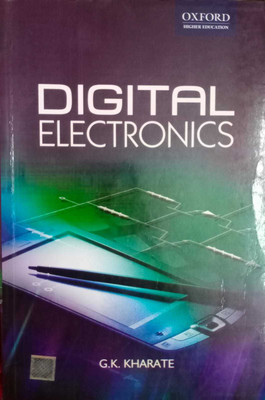Digital Electronics First Edition(English, Paperback, Kharate G. K.)
Quick Overview
Product Price Comparison
This textbook is intended for students of engineering majoring or non-majoring in the field of communications and engineering. Packing in the fundamentals along with supplementary content, the text is primed as a self-preparatory guide for all students. Summary Of The Book The book, Digital Electronics, is divided into ten chapters that are tailored to suit the readerŌĆÖs needs, which in this case refers to students of engineering and computer science. All of the chapters encapsulated in this text engage the gregarious use of illustrations and solved examples. All of this is focused on clarifying the concepts that are being explained through each of these chapters. The book opens with the subject matter related to logic families and here the features of Digital ICs along with various types of Logic such as RTL, DCTC, DTL, and TTL are explained among others. The second chapter moves into the domain of the Number Systems and Codes where various types of conversions are expounded. Along with this, Binary Processes and Codes are discussed in a thorough manner. The third chapter looks into Boolean Algebra and here students are familiarized with DemorganŌĆÖs Theorem, the Karnaugh Map Simplification and Logic Circuitry among other topics. The fourth chapter explicates the Combinational Logic Circuit and also the topic of Arithmetic Logic Unit and the Odd Parity Generator. The fifth chapter is completely focused on Sequential Logic, where One Bit Memory Cells, various Flip-Flops and their conversion, and Design of Sequential Logic are discussed. The next chapter deals with the Asynchronous Sequential Circuits where their Design, applicable flip-flops, and the problems and incompleteness of asynchronous circuits are detailed. The seventh chapter looks into Algorithmic State Machines and here its Realization, the RTL notations involved and VHDL are present. The eighth chapter follows the content of Programmable Logic Devices that includes PLA, application of different logic circuits with PLA and complex programmable logic devices. Converters are the main component in the next chapter where principles of Digital to Analog Conversion and Analog to Digital Conversion are discussed with all the associated processes. The last chapter looks into semiconductor memories where memory devices, ROM, RAM, PROM and NVRAM are discussed. All through these chapters, Digital Electronics involves an exhaustive number of review questions that is the key for the revision process of students and are important to gauge the understanding of the matter wrestled in each chapter. They follow in the multiple choice format and the book also provides numerous solved examples to confirm its practice-oriented layout. About G. K. Kharate G. K. Kharate is the Principal of Matoshri College of Engineering and Research Centre, Nashik. He received his Ph.D from the University of Pune and went on to embark upon a 20 year teaching career. He is a member of the Institution of Electronics and Telecommunication Engineers, the Indian Society for Technical Education, and the Computer Society of India. He has published a slew of articles published in national and international journals in his field of study in electronics and communication engineering. He was given a three lakh rupee grant by the University Of Pune.


